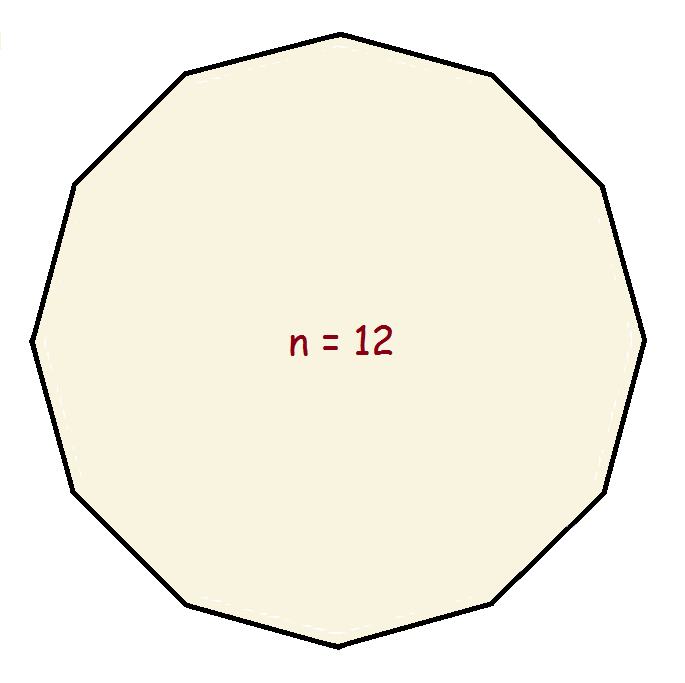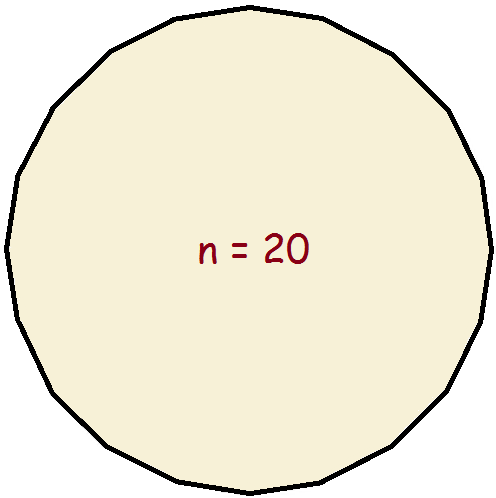
What do you think? Is the circle a polygon, or not?
As a result of watching a child’s video, I previously wrote a brief piece about the “corners” of a circle. The video was designed to teach children the various shapes—how many sides does a shape have, and how many corners?
The video maintained a circle has no corners. I called that into question. I still do. And yet, I do not. I now think it’s all in how you look at it. Or, you might say, it’s all in the mathematical perspective. Consider.
The Circle by Definition
One can define the two-dimensional circle as the complete collection or “set” of points equidistant from a set point, not part of the circle. In effect, a circle is like a symmetrically exploded point.1 Since it takes at least three points to create a corner, by derivation in this fashion, some say the circle has no corners. But is that the end of the discussion?
Circle a Polygon? By the Method of Limits
One can visualize a circle through the process of incrementally adding sides to a regular polygon. A triangle becomes a square; the square becomes a pentagon; the pentagon becomes a hexagon; the hexagon becomes a heptagon; the heptagon becomes an octagon; and so on.

Overcoming a Contradiction
Even if it could be accomplished, the number of sides would be infinite, rather than zero. There are two ways around this that I can come up with. Option one: it could be declared that a true circle can never be achieved using the method of limits. Therefore, a circle is not a polygon.
However, there is a snag to such a supposition: it suggests the method of limits is not strictly legit for other applications. Yet the concept of limits is the basis for the Calculus. Rather than follow this line of reasoning, perhaps it is better to adopt option two. Ignore the whole issue.
Finally!
My final take on the matter is that mathematicians need to take stock on reality. Math is only a tool. It, like computers or even words, is not an end in itself, only a tool. To say a polygon of ever increasing sides never makes it to a true circle is short-sighted. A circle is a polygon that has had its number of sides increased over endless time. It made it!
1 If one could say a point is “round”.
Note: You might also enjoy Point on a Line, a Line on a Plane, and a Plane in Space
References:
← Back to Math-Logic-Design
← Home

Allow me to suggest an alternate name for a circle — an infinigon. If that is the case, is not a cone then an infinigonal pyramid?
I brought up a problem like this to a math teacher at my school and I created 2 proofs that can prove a circle is a polygon… kinda. So here they are:
Proof #1
1. Take (n-2)180/n and make n=∞, one internal angle would equal 180.
2. The formula above only works for polygons.
3. The only shape that could ever satisfy the needs of (∞ -2)180/∞ =180 is a circle.
4. Saying this, because a circle has 360 deg. then a circle is considered a 2-sided polygon.
Proof #2
1. To find the internal angle of a shape you must find the least amount of triangles that can fit in it. (ex. 2 in square, 3 in pentagon)
2. A square has 2 triangles so they add up to 360 deg.
3. This means a circle is not 360 deg.
4. Taking (∞ -2)180/∞ =180 into account, the circle is now an infinite pointed shape with infinite deg.
Tell me what you think because this stuff fascinates me.
I’m not quite certain I am following Proof #2. But I really like Proof #1. Someone might try to claim (n-2)/n is not equal to 1 if n=∞, but I would disagree.
I enjoyed reading this but my math is not good enough to comment on the technicalities. Loved the point about math being a TOOL! Yes!
It might be worth considering that, being such that maths and language both evolved within our relative perspective, and relativity requires at least two points, all measurements being of at least two points to be valid. And allowing that all things in the outside are dualistic, perhaps it would be fair to say the circle has both no sides and infinite sides. This simply highlights that we don’t know what infinity really is.
Until we rediscover the relationship between infinity and “nothing”, paradoxical theories will always be interpreted either one way or the other, but rarely including both, and therefore we grasp at only one side of the relative equation but cannot comfortably conclude the answer to be “right” because in reality it is only “half right” without it’s counterpart.
Personally I blame the Ancient Greeks for their twisted, unreal and limited system of logic that replaced the far more real, meaningful and natural process of reason. On that, how does logic work within the framework of Cause and Effect? Logic says, A=B, therefore B=A. Completely untrue in the case of cause and effect. If A=horse, and B=cart, then logic allows you to put the cart before the horse. Reason does not allow this because that would be stupid. Logic allows and welcomes stupidity.
An interesting perspective. Perhaps a philosopher’s perspective. Even so, I like the concept of accepting both answers, zero sides and an infinite number of sides. And definitely, we do not understand completely the topic of “infinity”. Thanks for your comment.
Bence bu mümkün bizde okulda bu konuyu tartışıyoruz ve bu fikir benim çok işime yarayacak teşekkürler
Translation into English from Turkish of the above: I think this is possible, we are discussing this issue at school and this idea will be very useful to me, thank you.